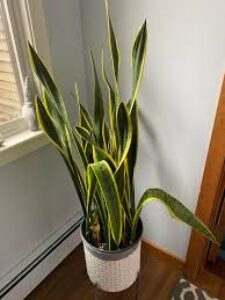
Snake plants, also known as Sansevieria or Mother-in-Law’s Tongue, are popular houseplants known for their striking appearance and low maintenance needs. They are perfect for busy individuals or those new to plant care, as they can thrive in various indoor conditions. However, like any other plant, snake plants are not immune to problems. Understanding the common issues that can arise and how to address them is key to keeping your snake plant healthy and vibrant. In this article, we will explore five common problems with snake plants and provide solutions to fix them.
1. Yellowing Leaves

Cause: Overwatering
One of the most common problems snake plant owners face is yellowing leaves. This issue is typically caused by overwatering. Snake plants are succulents, meaning they store water in their leaves and do not need frequent watering. Overwatering can lead to root rot, where the roots become waterlogged and begin to decay, causing the leaves to turn yellow.
Solution:
- Reduce Watering Frequency: Allow the soil to dry out completely between waterings. Water your snake plant only when the top 1-2 inches of soil feel dry to the touch.
- Check Drainage: Ensure your pot has adequate drainage holes to allow excess water to escape. Using a well-draining soil mix, such as a cactus or succulent mix, can also help prevent water retention.
- Remove Affected Leaves: Trim away any yellow or damaged leaves to prevent the spread of rot and improve the plant’s appearance.
Conclusion:
To prevent yellowing leaves, focus on watering your snake plant correctly and ensuring proper drainage. Overwatering is the most common cause of this issue, so less is more when it comes to watering snake plants.
2. Root Rot
Cause: Poor Drainage and Overwatering
Root rot is another common problem associated with snake plants, often resulting from overwatering or poor drainage. This condition occurs when the plant’s roots are exposed to excessive moisture for extended periods, causing them to become mushy and discolored. Root rot can be fatal if not addressed promptly.
Solution:
- Inspect the Roots: Remove the plant from its pot and examine the roots. Healthy roots should be firm and white, while rotten roots will appear brown, black, or mushy.
- Trim Affected Roots: Use sterilized scissors or pruning shears to trim away any rotted roots. Be sure to remove all affected areas to prevent further spread.
- Repot with Fresh Soil: Repot your snake plant in fresh, well-draining soil, and choose a pot with drainage holes. Allow the plant to dry out for a few days before watering again.
Conclusion:
To avoid root rot, ensure your snake plant is potted in well-draining soil and never sits in standing water. Proper watering techniques and good drainage are essential for preventing this common problem.
3. Brown Tips on Leaves

Cause: Underwatering or Low Humidity
Brown tips on the leaves of snake plants are often a sign of underwatering or low humidity. While snake plants are drought-tolerant, they still need occasional watering to maintain their health. Extended periods without water can cause the leaf tips to dry out and turn brown.
Solution:
- Adjust Watering Schedule: Ensure you are watering your snake plant appropriately, allowing the soil to dry out between waterings but not remaining dry for too long.
- Increase Humidity: If your home is very dry, especially in the winter months, consider increasing humidity around your snake plant. You can use a humidifier or place a tray of water near the plant to boost moisture levels.
- Remove Brown Tips: Trim the brown tips with sterilized scissors to improve the plant’s appearance. Be sure to cut at an angle to maintain a natural look.
Conclusion:
To prevent brown tips, maintain a balanced watering schedule and monitor the humidity levels in your home. Snake plants are hardy, but they need some moisture to stay healthy.
4. Soft or Mushy Leaves
Cause: Cold Damage or Overwatering
Soft or mushy leaves on a snake plant can indicate cold damage or, more commonly, overwatering. Snake plants are sensitive to cold temperatures and prefer to be kept in a warm, stable environment. Exposure to cold drafts or temperatures below 50°F (10°C) can cause the leaves to become soft and mushy.
Solution:
- Check Temperature: Ensure your snake plant is kept in a location with a consistent temperature between 60-85°F (15-29°C). Avoid placing the plant near drafty windows or doors.
- Avoid Overwatering: Follow proper watering practices, allowing the soil to dry out between waterings to prevent waterlogged conditions.
- Prune Affected Leaves: Remove any soft or mushy leaves with sterilized scissors to prevent further damage and encourage new growth.
Conclusion:
To prevent soft or mushy leaves, keep your snake plant in a warm environment and avoid overwatering. Proper placement and care are essential for maintaining healthy leaves.
5. Leaf Curling

Cause: Pest Infestation or Underwatering
Leaf curling in snake plants can be a sign of pest infestation or underwatering. Pests such as spider mites and thrips can cause damage to the leaves, leading to curling and distortion. On the other hand, underwatering can cause the leaves to curl as the plant attempts to conserve moisture.
Solution:
- Inspect for Pests: Check the undersides of the leaves for signs of pests, such as small webs or tiny insects. If pests are present, treat the plant with insecticidal soap or neem oil.
- Adjust Watering: Ensure your snake plant is receiving adequate water. Increase watering frequency slightly if the soil is consistently dry, but avoid overwatering.
- Maintain Cleanliness: Keep your plant’s environment clean and dust-free to deter pests and improve overall plant health.
Conclusion:
To prevent leaf curling, regularly inspect your snake plant for pests and ensure it receives adequate water. Maintaining a clean environment and proper watering schedule can help keep your plant healthy and pest-free.
Final Thoughts
Snake plants are known for their resilience and low maintenance, but they are not entirely free from common plant problems. By understanding the common issues that can arise, such as yellowing leaves, root rot, brown tips, soft or mushy leaves, and leaf curling, you can take proactive steps to address these problems and keep your snake plant thriving. Proper watering, good drainage, and regular monitoring for pests and temperature changes are key to ensuring your snake plant remains a healthy and beautiful addition to your home.







